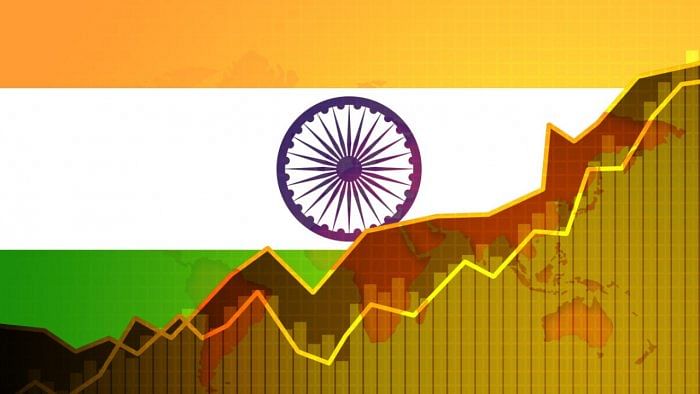
"When I first visited the US as a Prime Minister, India was the 10th largest economy in the world. Today, India is the 5th largest, and we will be the third largest soon," Prime Minister Narendra Modi said, with pride, in his address to the US Congress on June 23.
There was undoubtedly a sense of pride and big achievement in that statement. The constituency back home was also expected to feel elated and grateful for this spectacular achievement.
The International Monetary Fund (IMF) projects India’s GDP, in current US dollars, to reach $5.15 trillion in 2027 (India’s 2027-28), past the coveted $5 trillion mark, to cross the GDP of Germany (fourth largest) and Japan (third largest) currently.
What is making India jump places in GDP ranking? What will this mean for the nation and its people?
Most countries, we are moving past, have peaked at high incomes
India, with GDP of $1.86 trillion, was the ninth largest economy in 2013-14, with Brazil ($2.21 trillion), China ($9.57 trillion), France ($2.81 trillion), Germany ($3.7 trillion), the United Kingdom ($2.79 trillion), Italy ($2.14 trillion), Japan ($5.21 trillion), and the United States ($17.55 trillion) ahead.
It was quite a fortuitous coincidence that the GDP of next four countries — Brazil, Italy, France, and the UK in 2013 — was in a $2-3 trillion band, with India quite close behind. Moreover, except Brazil, all the three European countries had attained very high per capita incomes of $42,603 (France), $43,449 (the UK), and $35,560 (Italy) respectively. Brazil’s lower per capita income of $12,259 was also nearly 10 times India’s per capita income of $1,438.
All high-income countries get into low GDP growth orbit thanks to having attained economic prosperity and falling population, whereas developing countries record higher GDP growth. Unsurprisingly, India, a poor developing country, despite not so impressive growth of about 7 per cent, in current dollars during 2013-2022, moved past these four countries to become the fifth largest.
Germany and Japan are also high per capita income countries with declining population. Germany’s per capita income is $48,438 in 2022, whereas India’s is $2,389. Japan’s case is bizarre. Japan’s GDP was $5.76 trillion in 2010 and only $4.32 trillion in 2022. The IMF projects Germany and Japan’s GDP to be $4.95 trillion and $5.08 trillion respectively in 2027.
The IMF projects India’s growth, somewhat optimistically, at 8.72 per cent until 2027-28. If it gets realised, India will move past Germany and Japan that year.
It is not any special efforts of the Modi-led NDA government, but serendipity, India’s relatively higher, albeit modest, growth, and static economies of Germany and Japan which will make India the third highest economy in 2027-28.
The $5 trillion economy dream is getting distant
The Government of India announced in 2019-20 the goal of a $5 trillion GDP by 2024-25. India’s GDP was $2.84 trillion that year, needing a $2.16 trillion gap to cover in five years. India’s GDP reached $3.39 trillion in 2022-23 managing to cover only $0.55 trillion. We have a $1.69 trillion distance (three times that of $0.55 trillion) to fathom.
The government has not formally pushed back its $5 trillion GDP goal to any particular year. The Chief Economic Adviser (CEA) has talked about 2026-2027. The IMF projects India to go past the $5 trillion mark in 2027-28.
There is a big dimension, however, we usually miss-out in the discussion on a $5 trillion GDP sweepstakes. The US dollar has been depreciating quite materially since 2020. A US dollar in 2023 buys a lot less than a US dollar did in 2019-20 when India announced its $5 trillion GDP goal.
The US CPI was 117.2 in 2019. It rose to 132.4 in 2022 recording sharper dollar depreciation of 4.67 per cent per annum in these three years. Consequently, our $5 trillion goal of 2019-20 also equals $5.74 trillion in 2022-23. If we assume dollar depreciation of 3 per cent per annum until 2027-28, India’s $5 trillion GDP dream would require our GDP to be $6.65 trillion in 2027-28.
The IMF’s projection of $5.15 trillion GDP in 2027 is a lot less than $6.65 trillion. We will need to slog for a few more years before we achieve the $5 trillion GDP dream in 2019 prices.
We have hardly budged in per capita income ranking
Excluding small island economies, India’s per capita income of $1,438 in 2013-14 has increased to $2,389 in 2022-23, at a compounded annual growth rate of 5.8 per cent. India’s rank, in terms of per capita income, was the 147th (out of 189) in 2013-14. In the last nine years, we have moved to the 141st rank.
Since 2014, India has moved ahead of Nicaragua, Uzbekistan, Mauritania, Nigeria, Ghana, Kenya, and Lao PDR. On the other hand, Bangladesh — India’s ‘poor’ neighbour — has overtaken us. Per capita income of Brazil, Italy, France, and the UK, whose GDP India has overtaken, and Germany and Japan, which we will cross, remain far higher for us to even think of achieving.
The conclusion is clear. India will prosper and develop when the per capita income of average Indian will grow to reach higher middle-income levels, if not the high-income level — and not when its GDP becomes the third largest.
(Subhash Chandra Garg is former Finance & Economic Affairs Secretary, and author of ‘The Ten Trillion Dream’ and ‘Explanation and Commentary on Budget 2023-24’.)
Disclaimer: The views expressed above are the author's own. They do not necessarily reflect the views of DH.